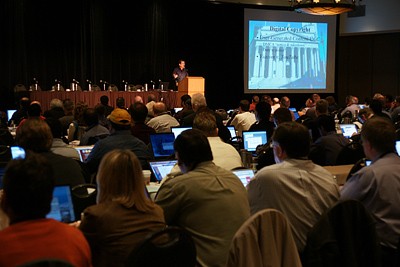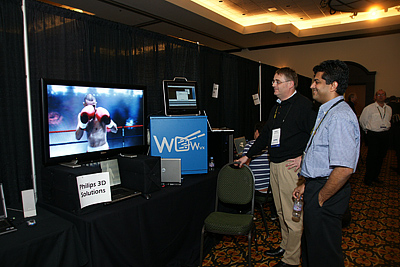Tech Retreat Boasts Impressive Lineup
RANCHO MIRAGE, CALIF.
Members of the moving image community are once again poised to swarm this small city, situated some 120 miles southeast of Los Angeles, for the annual Hollywood Post Alliance (HPA) Technology Retreat. This year's event marks the 15th such convocation of some of the best and brightest technical minds in the movie making and television production and broadcasting business, according to the convocation's organizer and "program maestro," Mark Schubin.
"We seem to have more SMPTE Fellows than a typical SMPTE conference," Schubin said. "And perhaps more PhDs than a small college."
The Feb. 18-20 event at the Westin Mission Hills Resort & Spa will feature presentations, panel discussions, reports and technology updates during its two-and-a-half day run.

A session in progress keeps attendees spellbound at the 2008 HPA Retreat. While the schedule of speakers is still being finalized, it is certain that the agenda will include at least 60 technical papers or reports on various aspects of the television and cinema industry. The program will also include five panel discussions addressing such topics as stereoscopy, new display technologies and advanced image processing.
Schubin said that among the growing list of presenters certain to be there, are James D. ("JJ") Johnston, one of the inventors of MP3; Merrill Weiss, who is recognized for his work in connection with the serial digital video interface and single frequency networks; and Tom Holman of THX fame. Dr. Hans Hoffman with the European Broadcasting Union will also attend, according to Schubin.
"He'll have a slot on the program to talk about test results of concatenated studio [AVC-Intra, JPEG2000 and XDCAMHD422] and distribution [H.264 AVC] compression at different frame rates," he said. "We think that he'll also have a demo room slot to show the effects, but that hasn't been finalized yet."
TELEVISION'S FUTURE
Schubin added that HPA organizers are never really sure what to expect before the retreat, "but we are looking forward this year to a BBC presentation on high frame rate television. What's different here from earlier high frame rate is that they're talking about watching television at 300 fps. The difference is mind-blowing; it's greater than the difference between SD and HD."
Schubin added he would be part of another presentation on future technology.
"I'm going to be talking about having the ability to correct lens aberrations electronically through deconvolution," he said. "If you have enough processing power, you can correct for all of the problems encountered in shooting. As processing power keeps going up and up and cameras have higher and higher resolution, you'll be seeing this sort of thing a lot."
PRE-RETREAT PROGRAM
Although the official welcoming address and kickoff assembly is at 9:00 a.m. on Wed., Feb. 18, a full lineup of pre-retreat activities has been scheduled a day earlier. These get underway at 9:30 a.m. on the 17th and include treatment of two hot-button issues that have been around since the dawn of DTV: maintaining lip-sync and controlling loudness levels. These will be addressed in a four-hour "ATSC Audio Summit, Ver. 2.0" seminar sponsored by the Advanced Television System Committee. Concurrent with the ATSC seminar is the Charles Poynton Workshop, which takes on "Mathematics for HDTV and Digital Cinema." (Poynton has been cited by Schubin as the originator of the 1080-line concept used in much of today's high-definition telecasting.) Also scheduled that evening are a wide range of demos almost too numerous to count. These are being conducted by companies with names that literally span the alphabet from A to X, including Apple, Dolby, Thomson Grass Valley, Omneon, Sarnoff, Tektronix, Telecast Fiber and XVD.
BREAKFAST ROUNDTABLES

Attendees enjoy a 3D demonstration at the 2008 HPA Retreat. Among the biggest draws at the retreat are the breakfast roundtables. The conference dining facility will be set up with numbered tables and a schedule of discussion topics corresponding to these numbers will be posted in the doorway. Attendees interested in a particular topic can sit at that table for an in-depth and very roundtable of that topic. A moderator is stationed at each table to maintain order.
"This is one of the most popular parts of the retreat," Schubin said. "A few years ago one of the guys hurt his shoulder in a softball game we were playing and had to be taken to the hospital. His injuries were pretty serious, but he was pushing for an early discharge to get back to the retreat and the next day's breakfast roundtables."
Depending on the topic, Schubin said a particular table may have chairs lined up four-deep. The sure sign of a dull topic is a table with only the moderator present.
THEY KEEP COMING BACK
The HPA Retreat has always been a big draw during its decade-and-a-half lifetime, and even the recent glum world economic news hasn't really cut attendance.
"The retreat has actually grown to what we feel is capacity at about 450 attendees," said Eileen Kramer, HPA's executive director. "It's a smaller, more intimate environment which encourages much more opportunity to talk to everyone there and spend one-on-one time with people."
"We usually have representatives of all the major Hollywood studios and all the major U.S. networks," said. Schubin. "We've also had international attendees from New Zealand to Norway."
NATO AND MPEG REPRESENTATIVES
Schubin added that the attendee roster in previous years has also included members of both NATO groups: the North Atlantic Treaty Organization and National Association of Theatre Owners; and those of both MPEG organizations: Moving Picture Experts Group and Motion Picture Editors Guild.
The conference wraps up Friday afternoon with a "post-retreat treat" arranged by Schubin on the Metropolitan Opera's Live Global Cinemacasts. Schubin, whose daytime job is engineer-in-charge of video operations at the Met, said that it will be a "how-we-do-it" type of affair, "with everything from robotic-track cameras to acoustic perspective."
Schubin will discuss many of the issues involved in the production. "Reception, projection, and such future possibilities as NHK's Super Hi-Vision, 3D, and getting to the South Pole—not so easy!" Schubin exclaimed.
Schubin said that if the dates hold for one of the Metropolitan's planned activities, he'll present a live transmission at the conclusion of the retreat.
Complete details of all retreat activities may be found on the HPA Web site, www.hpaonline.com.
Get the TV Tech Newsletter
The professional video industry's #1 source for news, trends and product and tech information. Sign up below.
James E. O’Neal has more than 50 years of experience in the broadcast arena, serving for nearly 37 years as a television broadcast engineer and, following his retirement from that field in 2005, moving into journalism as technology editor for TV Technology for almost the next decade. He continues to provide content for this publication, as well as sister publication Radio World, and others. He authored the chapter on HF shortwave radio for the 11th Edition of the NAB Engineering Handbook, and serves as editor-in-chief of the IEEE’s Broadcast Technology publication, and as associate editor of the SMPTE Motion Imaging Journal. He is a SMPTE Life Fellow, and a Life Member of the IEEE and the SBE.

